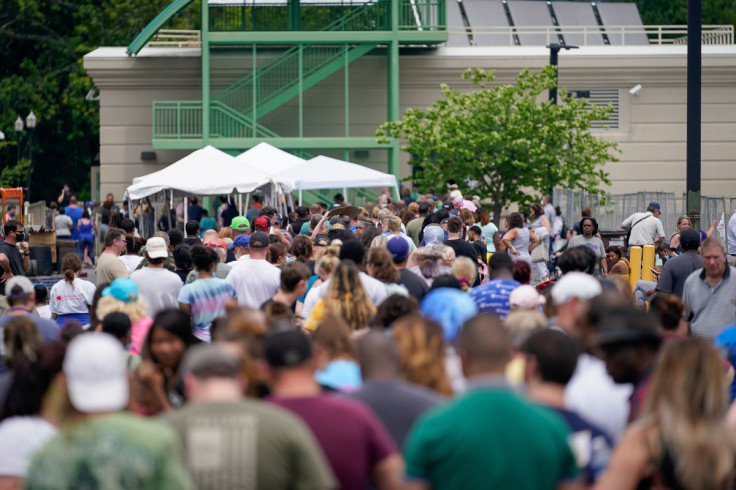Hawkish Fed May Not Be Deterred By Spate Of Inflation-friendly Data

Dropping job vacancies, a dip in rental costs and signs of growing consumer caution may bolster the Federal Reserve's hopes it can still slow the U.S. economy - and inflation - without causing a full-blown recession or dramatic rise in unemployment.
U.S. central bank officials remain adamant that inflation is their prime focus, and, even as they site what Atlanta Fed President Raphael Bostic this week called "glimmers of hope," they remain on message about their determination to slow the pace of price hikes, a group mantra that galvanized after policymakers stumbled last year in thinking inflation wouldn't take root.
"We are still decidedly in the inflationary woods, not out of them," Bostic said after noting that some recent data had broken in the Fed's favor.
Still, those "glimmers" may show the impact of Fed rate increases beginning to be felt beyond financial market volatility and in the real economy where prices are set.
Rents, a major component of the consumer price index, declined in the three months from July through September according to a recent report from Apartments.com, reversing a year and a half of strong growth.
Consumer spending in August barely grew after adjusting for inflation, and recent census surveys have shown 40% of people struggling to pay bills - and perhaps ready to tighten their wallets in a step that could slow demand and ease prices.
Job vacancies in August dropped by 1.1 million, the largest decline outside the onset of the coronavirus pandemic and a trend, if continued, that would fit a central piece of the Fed's narrative for how inflation could be brought down without workers paying too steep a price.
The hope is that hiring can continue even as the pressure for higher wages eases, with companies trimming their employment plans without resorting to layoffs.
The Labor Department's employment report for September, due to be released at 8:30 a.m. EDT (1230 GMT) on Friday, will add an important data point, with policymakers hoping the number of new additional jobs slows from the torrid pace seen during the post-pandemic reopening of the economy - an average of about 512,000 jobs gained per month since the beginning of 2021 and 381,000 per month in the last six months - to something like the average 183,000 per month reported from 2010 through 2019.
A Reuters poll showed economists at the median expect that 250,000 jobs were added in September.
GLOBAL REPERCUSSIONS
The Fed almost certainly will deliver its sixth rate hike of the year at its next policy meeting on Nov. 1-2, with markets widely expecting a fourth straight three-quarters-of-a-percentage-point move.
That comparatively large step had not been used since the early 1990s, but when the Fed's preferred measure of inflation spiked in the spring to more than triple the central bank's 2% target, policymakers pivoted quickly towards the fastest tightening of credit since the 1970s and early 1980s.
The repercussions have been global - a soaring dollar, rising concern of a worldwide recession, signs of stress in some financial markets, and calls for the Fed to at least slow the pace of upcoming increases in borrowing costs.
The rhetoric of Fed officials has remained strict so far, with promises to remain "resolute" and to "keep at it" until inflation is falling, and little sense that concerns about global financial conditions or market volatility were causing them to rethink the game plan.
In remarks on Thursday that referenced things like falling rents and job vacancies, Fed Governor Lisa Cook said she still needed to see "inflation actually falling," while Minneapolis Fed President Neel Kashkari said the bar to any policy change is "very high" at this point.
In a recent look at the globally important market for U.S. Treasury securities, Piper Sandler analysts Roberto Perli and Benson Durham said that even if there were signs of "illiquidity," trading would have to become "dysfunctional" for the Fed to react.
"Illiquidity will not sway the Fed; dysfunctionality could," they wrote. "However, the market is not dysfunctional; Yields still move in the direction they should given the macro outlook," particularly the uncertainty about inflation.
Contracts tied to the target federal funds rate continue to price in an increase of three-quarters of a percentage point next month.
A run of data showing the economy beginning to ease as Fed officials hoped - not crashing as others feared - could push a group that in September was closely divided over what to do next towards a smaller rate increase of half a percentage point.
Policymakers will get another key bit of data to digest next week when the Labor Department releases its Consumer Price Index report for September.
Even if the effects of tighter monetary policy are beginning to show up, that may not be enough for the Fed to alter its policy plans yet.
Economists polled by Reuters expect core consumer inflation, stripped of the most volatile food and energy components, actually rose last month, with prices forecast to increase at a 6.5% annual rate versus 6.3% in August.
Karen Dynan, in a forecast prepared for the Peterson Institute for International Economics, said that to control inflation the Fed would need to raise the benchmark overnight interest rate perhaps a percentage point higher than policymakers themselves expect, into the mid-5% range, likely triggering a mild recession and a half-percentage-point contraction in gross domestic product in 2023.
Recent data is "helpful," said Dynan, an economics professor at Harvard University, but "it is not enough for them to back off what they are doing ... We have now had nine months of economic growth that has been pretty tepid, and strong language from the Fed, and we have not made any progress on inflation."
© Copyright Thomson Reuters {{Year}}. All rights reserved.





















